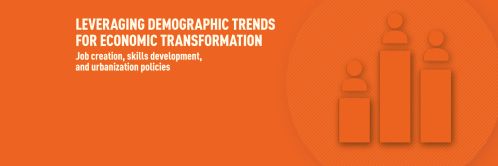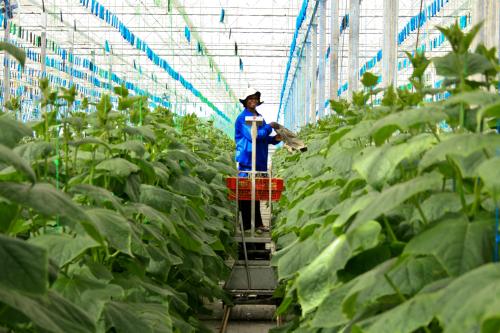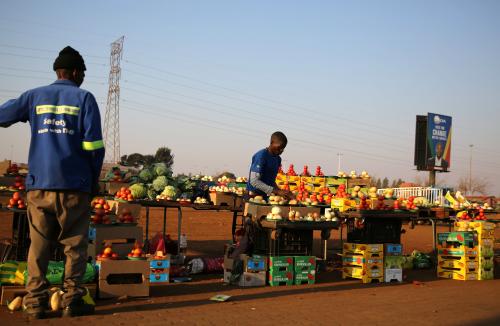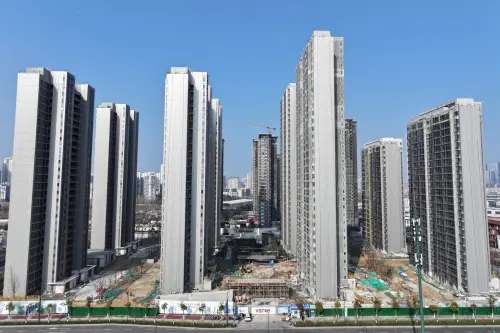Editor’s Note: This blog is part of the larger
Foresight Africa 2015
project that aims to help policymakers and Africa watchers stay ahead of the trends and developments impacting the continent. You can read the full report
here
.
South Africa Should Prioritize Inclusive Growth in 2015
In order for South Africa to make headway against its three interrelated and most pressing economic challenges of unemployment, poverty and inequality, a more inclusive economic growth path must be chartered. While it is true that no country in history has successfully reduced unemployment and poverty without consistent economic growth, growth alone is insufficient when inequality levels are high. Indeed, inequality can neutralize the gains made from growth. This concern is particularly pertinent in South Africa, where colonial conquest and apartheid resulted in large benefits to a small elite and the impoverishment of the majority, creating a growth path that entrenched extreme inequality in every respect. Since the beginning of democratic rule, the government has managed to increase the provision of public assets and services to the poor and introduced an expanded social grant system with significant positive effects. Yet, despite these efforts and a period of sustained economic growth, unemployment, poverty and income inequality remain exceptionally high.
A sharp departure from the current growth trajectory is required. Broadly, an effective solution must focus not only on stimulating growth in key industries but concurrently pulling in those currently isolated from the benefits of growth. At present, the South African economy relies on a high skills-biased services sector, and a capital-intensive manufacturing and resources sector. In turn, the public sector has become a key provider of employment in the last decade. Such a growth model is not suitable for long-run welfare gains.
Despite Rapid Growth, South Africa Still Faces High Poverty and Inequality
Leading up to the third quarter of 2008, when the global economic crisis struck, South Africa had experienced one of its longest periods of uninterrupted economic growth—55 quarters averaging between 3 and 5.6 percent annually. In 2009 the country posted negative growth rates for the first time since 1994 and shed approximately 900,000 jobs in a real economy crisis emanating from the unregulated excesses of financial institutions in the developed world. GDP growth began to recover relatively quickly but it remains weak and has yet to return to pre-crisis levels. Similarly, employment took almost five years to surpass its pre-crisis peak of 14.8 million.
Economic growth thus far has done little to reduce poverty or unemployment and has only served to reinforce income inequality in South Africa. While the results differ depending on the period selected and the variable under scrutiny (income or expenditure), the broad conclusion is that using a cost-of-basic-living poverty line, household poverty fell by about 2 percent in the first decade after 1994 and then remained unchanged. A key result accompanying this, and one that partly explains the tepid poverty declines, is that income inequality remains stubbornly high. In addition, using the International Labor Organization’s (ILO) definition of joblessness, unemployment stood at about 25 percent for the first quarter of 2014.
There have, however, been some successes that suggest the presence of policy interventions that are helping to generate and support a more inclusive growth path. Significant gains have been made in the area of social protection through government grants, although questions regarding the long-term sustainability of this strategy remain unanswered. Government spending on social assistance now constitutes 10.4 percent of total expenditure and 3.4 percent of GDP. This significant fiscal outlay has resulted in one of the deepest and widest social security systems within the developing world—very similar to those found in economies such as Brazil, Mexico and Venezuela. Indeed, as a recent World Bank study indicated, South Africa’s social security system is more inequality-reducing than Brazil’s (World Bank 2014). Without these fiscal allocations to old age pensions, disability grants and child support grants in South Africa, both poverty levels and income inequality, as empirical estimates suggest, would be much higher.
In addition to the social grant system, the government’s delivery of public assets and services has been one of the most successful developments in the post-apartheid economy, although many problems remain as evidenced by frequent service-delivery protests. When measuring the provision of housing, electricity, water and refuse removal, results show that non-income poverty, as measured by access to public assets, declined dramatically between 1993 and 2011. Poorer areas and female-headed households have also been well targeted. Asset and service delivery are crucial to addressing inequality of opportunities but it is clear that the real challenges remain in the labor market and the way the economy is structured, where the enduring legacies of apartheid are much more difficult to tackle.
Policies for an Inclusive Growth Agenda in 2015
In considering policies to achieve more inclusive growth, most economists agree that a stable macroeconomic environment, with a competitive exchange rate and a carefully managed fiscus, is a sine qua non for long-run economic growth. The more opaque, and indeed more vexed, element of any growth agenda, particularly an inclusive growth agenda, is ensuring an optimal mix of policies that improve the micro-foundations of economic growth. These micro-foundations include education and skills training, industrial and trade policy, labor market policies, and competition policy. Taking into account the post-apartheid growth dividend and the character of the South African economy, we offer some guiding principles for developing the micro-foundations of an inclusive growth strategy in 2015.
- The private sector—and by extension, self-employment—should remain central to the discussion of inclusive growth. Globally, evidence suggests that nine out of 10 working individuals are in the private sector. An inclusive growth strategy that does not harness the creativity, innovation and competitiveness of the private sector is doomed to fail. In South Africa the start-up costs for small businesses are relatively high, and the cost of doing business more generally should be reduced in order to support the growth of local entrepreneurs, attract foreign direct investment, and engage the private sector in the process of inclusive growth. Currently, South Africa is too dependent on the public sector for employment creation. A bloated public sector with queuing for jobs is not growth enhancing.
- South Africa must emphasize the creation of a labor-intensive manufacturing sector. For many of the world’s most dynamic developing economies, a globally competitive, employment-intensive light manufacturing sector has been instrumental in the process of economic transformation (Dinh et al. 2012, World Bank 2012). The experience of countries such as South Korea, Malaysia, Thailand and China makes this an obvious proposition, particularly for urbanizing countries such as South Africa. However, South Africa’s manufacturing sector is uncompetitive and moribund: Manufacturing’s contribution to GDP has fallen from 19 percent to 17 percent between 1995 and 2013, while its share of formal sector employment has declined from 15 percent to 12 per cent over the same period. South Africa needs a dynamic light manufacturing sector and a focused industrial policy that provides some form of infant industry protection. This will be critical to generating the kind of employment the economy so desperately requires.
- The informal sector should not and cannot be ignored by policymakers. South Africa’s relatively small informal sector is another crucial focus area for policymakers. With less than 20 percent of total employment classified as self-employed in South Africa, international comparisons indicate that there is an insufficiently low number of individuals employed in this segment of the labor market. Surplus labor in most comparable middle-income countries is absorbed into a vibrant, if somewhat less than ideal, informal economy. South Africa’s surplus labor, however, is represented almost solely in the form of an extraordinarily high open unemployment rate. One important strategy, then, in the pursuit of inclusive growth, is to ensure that economic opportunities are provided for the informal sector. The structure and nature of the South African economy—ranging from product and credit market access, to local government regulation and state procurement policies—actively discourage economic activity in the informal sector (Verick 2011). The pursuit of an inclusive economic growth strategy should therefore attempt to ensure that relevant policy interventions are designed in a manner that does not actively marginalize the informal economy within the process of economic growth. In South Africa, insufficient attention has been paid to this form of policymaking, with the consequence that joblessness, instead of some form of (albeit sub-optimal) informal employment, has been the dominant outcome from economic growth since 1994.
- Addressing the inadequacy of advanced skills and mismatch of existing skill sets for the labor market must be balanced between educational quantity and quality. It is well-known that South Africa suffers from a fundamental imbalance between the kind of jobs available and the level of education and skills held by the majority of the unemployed. Primary school enrollment, for example, is close to 100 percent in South Africa yet the average quality of this schooling is poor by most cross-country standardized test score estimates. The problems within the school system are many and varied, and range from shortages of infrastructure essential for learning (including desks and textbooks) to poor teaching practices. These issues are often more acute in rural areas. Unfortunately, the difficulties persist through to high school where the pool of students who are competent in core subjects such as science and mathematics is vanishingly small. Extraordinary dropout rates characterize the high school system in South Africa, where out of every 100 pupils that start grade 1, only 40 successfully finish high school and just 12 will qualify for university. Most university graduates easily find employment but among school leavers who do not attend a university, unemployment rates readily exceed 25 percent. There is scope for more training colleges that equip matriculants with practical, marketable skills and, in this regard, a focus on post-school (non-university) education built around a technical and vocational education and training (TVET) system is essential.
- South Africa should capitalize on its comparative advantage in physical, financial and telecommunication infrastructure as a platform to attract foreign firms seeking a foothold in Africa. Despite being locked into a low growth trap on a continent with some of the world’s fastest growing economies, South Africa—Africa’s second-largest and most advanced economy—still remains central to the region and the continent’s future. The 20 percent purchase by the Industrial and Commercial Bank of China of South Africa’s Standard Bank in 2008 is indicative of the indirect impact the growth of African economies is having on South Africa. South African firms are dominant in retail, mining and telecommunications on the continent but the long-run growth question is whether these companies can capitalize on their early mover advantage and become the dominant investors in a region where FDI flows from China, India, Malaysia and other emerging markets are rapidly expanding.
- Labor market interventions. Certain labor market interventions that address unemployment (and thus indirectly impact poverty and inequality) are also possible. Currently the state engages in several public employment creation schemes, such as the Expanded Public Work Program (EPWP) and Community Work Program (CWP), but these are not large enough to make a significant impact and do not offer full-time work for participants. Alternative channels must be investigated. There is a strong view that, in South Africa, business and labor are able to divide up the rents from growth in a semi-consensual form resulting in high dividends and wages that are high relative to similar emerging markets (Mahajan 2012). This is to the exclusion of the unemployed—a sort of “high-profit, high-wage” unemployment equilibrium. As a solution, some call for lower wages and less stringent labor policies, but lower wages are neither a desirable nor a feasible response, and there is no evidence to indicate that the South African labor environment is particularly restrictive. Instead, well-crafted policies that serve to reduce the cost of labor through state subsidies have the potential to increase employment over the long term.
- The government must re-establish trust with the business sector and help to ensure a stable social pact between themselves, business and labor. Industrial relations in South Africa involve agreements between three major stakeholders: business, organized labor and government. These relationships have become increasingly strained. While unrest and strike activity are a common feature of labor relations, where vocal and politically influential trade unions bargain with business on a regular basis, strike activity and general social unrest through protest have escalated in recent years. The killing of 34 striking mineworkers by police on August 11, 2012 in Marikana tragically marked, among other things, a turn away from organized bargaining that threatens economic stability more generally and points to the failure of industrial relations in the mining sector in particular. It is also crucial that government views its role at labor-government-business fora as representing the unemployed, whose livelihoods depend in part on the outcomes of these negotiations.
Conclusion
There can be no doubt that in three areas, post-apartheid South Africa has yielded strong and positive progress: macroeconomic policy, social assistance and public asset delivery. From the management of the fiscal deficit, to pro-poor and anti-inequality social grants and the delivery of housing, electricity and water—the first two decades of democracy have been a very successful period for the South African economy. However, the persistence of low growth, driven by significant microeconomic constraints—continues to reinforce the economy’s middle-income country growth trap. A top priority in 2015, and indeed beyond, is that of inclusive growth. Tackling these microeconomic constraints on growth—ranging from a poor quality education and TVET system and insufficiently small microenterprise sector, to increasing light manufacturing employment and improving the industrial relations environment—lies at the heart of South Africa’s next 20-year growth project.
The Brookings Institution is committed to quality, independence, and impact.
We are supported by a diverse array of funders. In line with our values and policies, each Brookings publication represents the sole views of its author(s).






Commentary
Foresight Africa 2015: The Pursuit of Inclusive Growth in South Africa—Constraints and Opportunities
January 29, 2015